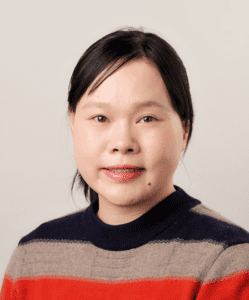Posted By: HGG Advances
Each month, the editors of Human Genetics and Genomics Advances interview an early-career researcher who has published work in the journal. This month we check in with Jingjing Yang (@jjloverp) to discuss her paper “A scalable Bayesian functional GWAS method accounting for multivariate quantitative functional annotations with applications for studying Alzheimer disease”.

HGGA: What motivated you to start working on this project?
JY: This project was motivated by my previous work about developing a Bayesian Functional GWAS (BFGWAS) method to account for non-overlapped categorical functional annotation for multivariate GWAS. Our previous work of the initial BFGWAS method has shown the advantages of accounting for functional annotations for fine-mapping and prioritizing GWAS signals, but it has the limitations of assuming one annotation category per genetic variant and requiring individual-level GWAS data. This work extends the BFWAS framework to account for multivariate quantitative functional annotations and the use of summary-level data.
HGGA: What about this paper/project most excites you?
JY: I am most excited about deriving an MCMC algorithm that requires only summary-level GWAS data but approximates the results that could be obtained by using individual-level GWAS data. By applying the BFGWAS_QUANT tool to GWAS summary data of Alzheimer disease with eQTL and histone modification-based annotations, we found GWAS signals were most enriched with H3K27me3 (polycomb regression) and cis-eQTL in microglia (a disease relevant cell type), as well as fine-mapped 32 GWAS signals out of 1073 genome-wide significant variants.
HGGA: What do hope is the impact of this work for the human genetics community?
JY: I hope the BFGWAS_QUANT method developed in this work can be useful for the genetics community to leverage publicly available large-scale GWAS summary data and quantitative functional annotations based on multi-omics data, especially for quantifying the enrichment of functional annotations and fine-mapping potential causal genetic variants.
HGGA: What are some of the biggest challenges you’ve faced as a young scientist?
JY: The biggest challenges are securing extramural funding to support my research projects and recruiting motivated trainees with matched research interests and skills.
HGGA: And for fun, what is one of the most fascinating things in genetics you’ve learned about in the past year or so?
JY: The most fascinating things in genetics I learned about in the past year is that multiple-omics data can now be profiled at single cell level by the evolving next-generation sequencing technology.
